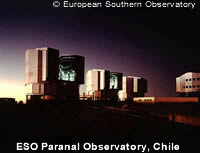ESA to test new technique for detecting extrasolar planets
The European space agency (ESA) and the European southern observatory (ESO) are pooling their expertise to build an instrument which will test a new method of searching for extra-solar planets. The ESA says that searching for dim planets around bright stars 'is like looking for a candle flame next to a searchlight.' But new advances in the technique of nulling interferometry, which combines the signal from several different telescopes to cancel out the light from the central star, are now to be put to the test in a new ESA/ESO instrument called GENIE (Ground-based European nulling interferometer instrument). The instrument will perform nulling interferometry using ESO's Very Large Telescope, a collection of four eight metre telescopes installed in Chile, in the biggest ever investigation of the technique to date. Using GENIE will provide invaluable information for engineers constructing the 'hub' spacecraft of the Darwin mission, a flotilla of six space telescopes and two spacecraft which will search for Earth-like planets around stars. The hub craft will combine the light from the telescopes to help its search. Malcolm Fridlund, project scientist for the Darwin mission, said: 'If you see the way of getting to Darwin as being outlined by a number of technological milestones, this is one of the most important ones.' The GENIE instrument is expected to be operational by 2006. Darwin is scheduled for launch in the middle of the next decade.



